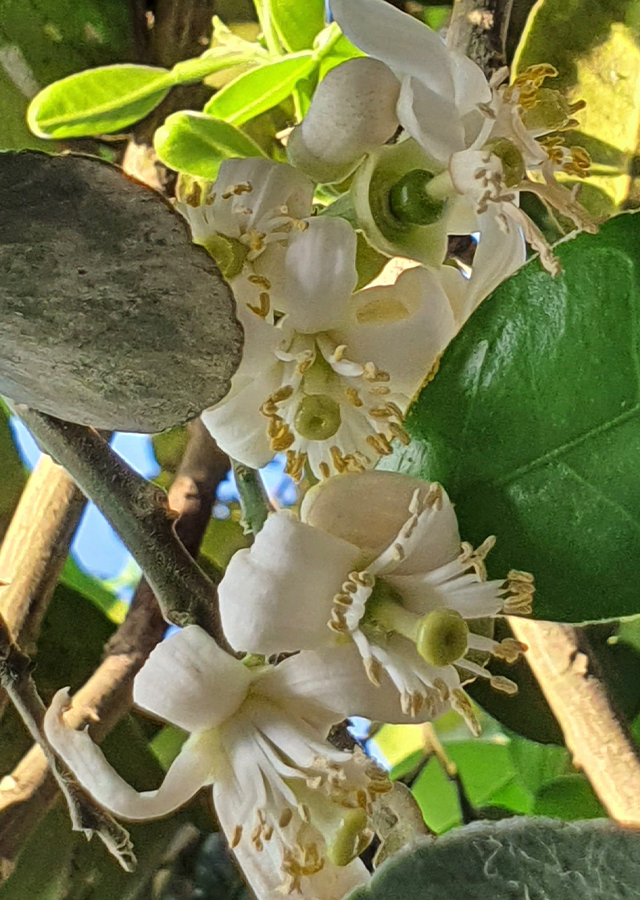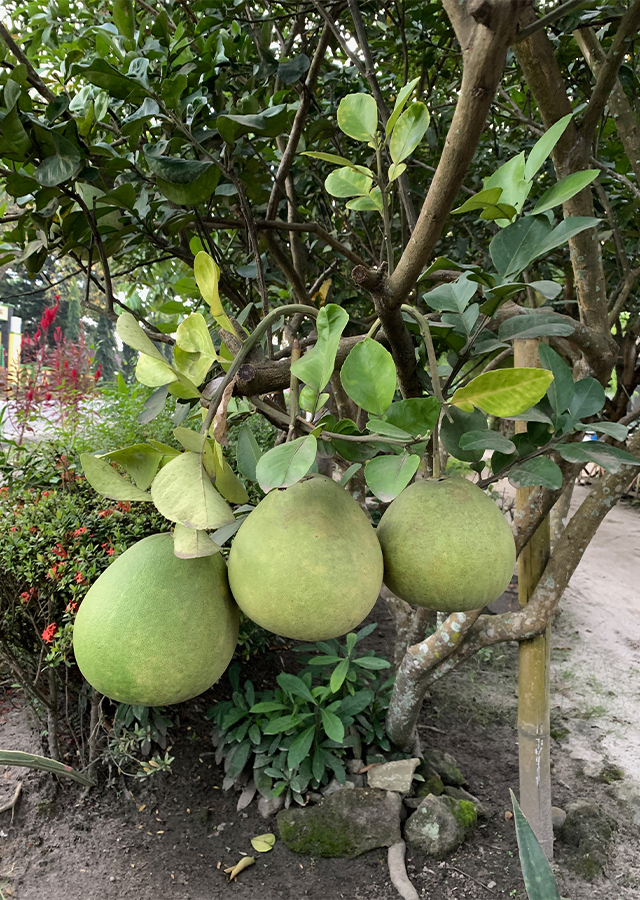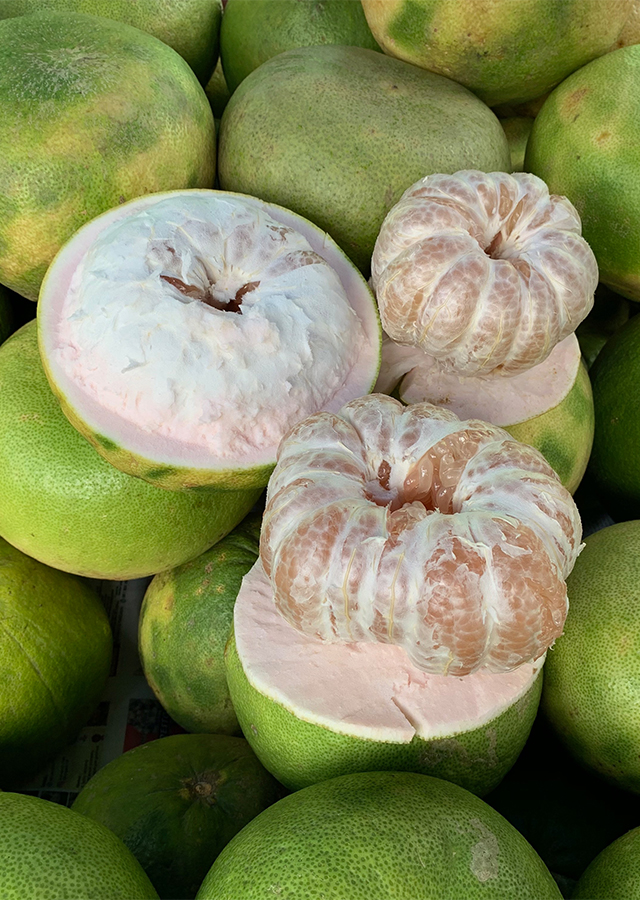Pomelo
Citrus maxima (Burm.) Merr.
Rutaceae
Location in our garden
Orchard



Synonym
Aurantium decumana (L.) Mill.
Aurantium maximum Burm.
Citrus grandis (L.) Osbeck
Habitus
Trees. Low-branching, evergreen tree, growing up to 5 - 10 m tall
Part Used
Leaves
Seeds
Bark
Flowers
Fruit
Rind
Stem
Growing Requirements
Full Sunshine
Habitat
Terrestrial
Overview
"Pamelo" or "jeruk besar", as Indonesian said, is native to Malesia. It is grown commercially in Asia for its large edible fruit. There are several cultivar grow in Indonesia, e.g Giri Matang (Bireun, Aceh), Cikoneng (Sumedang, Jawa Barat), Muria (Kudus, Jawa Tengah), Bageng Taji (Pati, Jawa Tengah), Nambangan, Adas Duku, Sri Nyonya, Gulung, Jawa (Magetan, Jatim), Pangkep merah and putih (Pangkep, Sulawesi Selatan).
Vernacular Names
Pummelo, shaddock, pomelo (En), Som o (Thai), Bưởi chùm Thái Lan (Vietnamese), Pu tao you (Chinese), Buntan (Japanese), Apfelsinenbaum (Germany), Pompelmo (Italy), pamelo or jeruk besar (Indonesia).
Agroecology
Pomelo thrives in the lowland tropics. The crop is not grown above elevations of 400 m. It prefers a deep, well-drained but moisture-retentive loamy soil in full sun in a pH range 5-6. Irrigation is needed when the dry periods is more than three months.
Morphology
- Stems - has a distinctive smell when peeled. Glandular dotted. usually purplish, flat with ridges when young.
- Leaves – has a distinctive smell when crushed. Glandular dotted. Blade broadly ovate or to elliptic, thick, dark green, base rounded, apex rounded to obtuse and sometimes mucronate.
- Flowers - purplish or rarely milky white. Calyx 3-5-lobed. Petals 1.5-2 cm. Stamens 25-35, some undeveloped. Style long and thick.
- Fruits – green to yellow, subglobose to pyriform berry. Densely glandular dotted. Fruit mature 7-10 month after flowering. The main harvest month in Jawa are April-June.
- Seed – monoembrionic, large, brownish. Seedling has spiny habit.
Cultivation
- Pomelo can be propagated by seeds, cuttings, air layering, grafting or top working. Seedling has spiny habit. Plant from cutting and air layering have short roots so they will be sensitive to drought.
Chemical Constituents
Vitamin C, pectin, carotenoid (ex: licopen), flavonoid (limonoid, naringin, quercetin, myricitin, tangeritin, hisperidin), limonoid (ex: limonin and nomilin), tanin, marmin, β-sitosterol, 5,7-dihydroxylcoumarin, xanthotoxol, 1,3,5-trihydroxyhenzen.
Traditional Medicinal Uses
Medicinal Uses
The trees are grown for the medicinal applications of leaves, flowers, fruits and seeds, including the treatment of coughs, fevers and gastric disorders. Fruit chemical contents are beneficial for human health, e.g as antiviral, anti microbial, anticancer, anti obesity.
- Leaves, flowers, fruits and seeds, including the treatment of coughs, fevers and gastric disorders.
- Fruit juice with its pulp, with honey, is given to improve urinary flow.
- Infusion or decoction of flowers, leaves and pericarp used as sedative for nervous affections; also for coughs and ulcers.
- Peel or rind, dried or in decoction, used for dyspepsia.
- In Malaya, lotion of boiled leaves used for painful swellings.
- In the Himalayas, fruit juice recommended for ulcers; used in diabetes; and mixed with black pepper and a little rock salt, used for malaria.
Traditional Uses
Fruits- Fresh fruits, juice, pectin production, marmalades.
Pulp – cattle feed.
Flower and/or leaves – essential oil
Part Used
Reference Sources
- Fern, ken. (2019). Useful Tropical Plants. Citrus maxima. http://tropical.theferns.info/viewtropical.php?id=Citrus+maxima. 23-02-2021.
- Niyomdham, Chawalit. (2016). Pl@nt Use. Citrus maxima (PROSEA). https://uses.plantnet-project.org/en/Citrus_maxima_(PROSEA). 23-02-2021
- Flora of China. (No date). Citrus maxima. http://www.efloras.org/florataxon.aspx?flora_id=2&taxon_id=242412666. 23-02-2021
- NIH. (2015). National Library of Medicine. [Chemical Constituents from Young Fruits of Citrus maxima cv. Shatian]. https://pubmed.ncbi.nlm.nih.gov/26930983/. 23-02-2021
- StuartXchange. (2018). Philippine Medicinal Plants. Suha. http://www.stuartxchange.org/Suha.html. 23-02-2021.
- Susanto S, Rahayu A, Tyas KN. 2016. Pamelo Indonesia dan kajian ekofisiologisnya. IPB Press, Bogor Indonesia. 112p.


